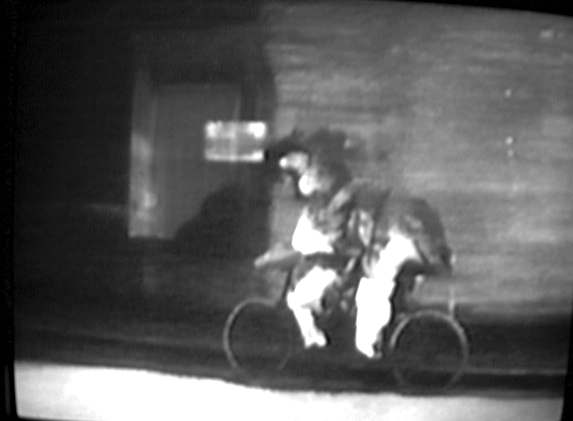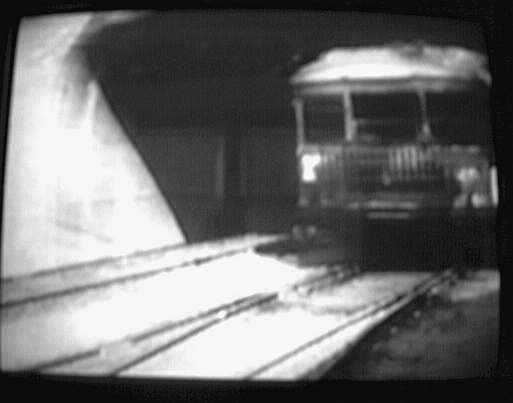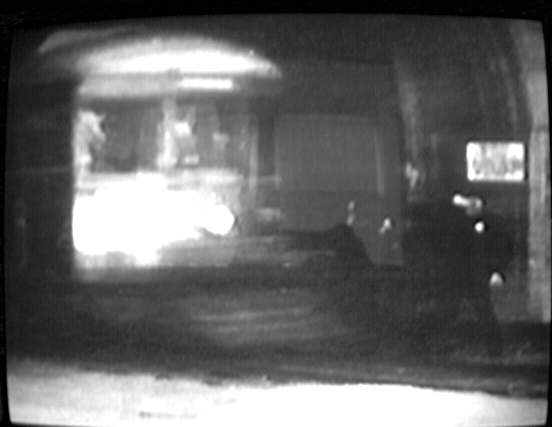But first, how about THIS L.A.
Railway location, from a Mack Sennet "Keystone
Kops" film |
|
Who can Identify the location of these 1930 L.A. Trolley Scenes??
Updated Thursday April 29, 2003
Here were some discussions about it among some L.A. & trolley fans
In
1930, Laurel & Hardy starred in a Hal Roach Movie,
"Another Fine Mess," filmed somewhere in Los
Angeles. The final scenes involve them in a moose outfit on
a bicycle, being pursued by policemen along an upper-class
residential street (Beverly Hills or Hancock Park??). they
suddenly leave this street and obviously enter another part of
Los Angeles for the ending.
They enter a fairly busy street, just as the two streetcar tracks
appear to make somewhat of an S-curve, and there's a Richfield
service station in the background. There follow a
couple VERY brief light/dark scenes of little visual value, and
then come out, along the tracks, with what appears to be a
"mural" billboard, which appears to possibly be an ad
for the view from Mount Lowe/Echo Mountain at night.
They enter the tunnel, which I first took to be the Toluca subway
portal, but now I have serious doubts. After a
Hollywood-type car, probably 625 or 725 (see John Hitzeman's comment
at bottom),
enters the tunnel, there is very obviously a siding coming TOWARD
the camera...is this more like the south portal of the Hill
Street tunnel, with the "courthouse" spur?
Besides that, as they leave the tunnel there is a distinctive
concrete-appearing lattice-type retaining wall, which would not
seem to fit Toluca at all...it's on the wrong side of the
right-of-way.
But first, how about THIS L.A.
Railway location, from a Mack Sennet "Keystone
Kops" film |
|

Would the Exit be at the location of this photo, and, if so, which tunnel exit is it...

Where are there pictures of the area between the two tunnels...that is from and including the south portal of tunnel #1 and the north portal of tunnel #2. What was in that area, and what is the east-west cross street (the one below California)? I know the tunnel was reinforced under California Street (R.I.P.) to account for heavier vehicles passing overhead...
This map, from Baist's Real Estate Atlas of Surveys of Los Angeles, California (Philadelphia, 1921) was photographed at Los Angeles Public Library and contributed by Piet Schreuders.

 |
 |
Piet also has provided these "pans" of scenes from the movie. Very helpful. THANKS, Piet!
SCROLL way to the right ~~~>
because the scene moves from right to left
<<<~~~~~~~

His title:
"AFMpan = the overview of the boulevard. Which
boulevard??"
(I'm guessing Sunset, now)

His title:
"AFMentry = the 'buffalo' entering the tunnel. Which entry?
Not sure."

His title: AFMexit = two cyclists exiting at "AFM exit", north of Temple Street.

1 - Coming onto main drag
Update: Could this not be
coming south off N Grand Avenue onto Sunset Blvd., looking west
on Sunset ?

Onto the street, ( "s-curve in
tracks?), Richfield Station behind them, lettering is very clear
in some film frames
If it's on the approach to the North
end of tunnel #1, that would have been at Sunset near Grand
Ave. Anybody know?

On private way approaching tunnel, writing
on wall appears to be billboard, perhaps for view from Mount
Lowe.
Would there have been any logic - or
space - for a large mural-billboard like this at any of the other
three "Hill Street" portals, other than at the
Sunset Blvd location?

Left side of same billboard painted on
wall...city street lights from above??

? 25 enters tunnel
While appearing in the film just after
L&H enter the tunnel, as if the car were following them in,
wouldn't this now seem to be at the south end of Tunnel #2, with
the courthouse spur in the immediate foreground...and the
location where they are seen leaving the tunnels.
Also - duh - the shadows, assuming they're natural, couldn't be at the north portal of anything, but probably the south end. And in the first two pics above the shadows are weak but behind (north of) the bike riders.

Entering tunnel, rectangular sign painted
on wall. (Glare to left of sign is camera-caused)
Tracks are mostly in shadow...north
end ?

Car enters tunnel, note siding in
foreground
In this and the remaining
views, the tracks are in sunlight...south end ?

Tracks at portal - two tracks, plus siding
in foreground

Unknown car leaving tunnel, cops against
wall by ? sign
Glare between car and cops is camera's fault.

Laurel & Hardy leaving tunnel, between
the tracks; sign on facing wall

Farther from portal, concrete-construction
retaining wall behind them?
Any
suggestions, educated guesses or downright certain answers will
be appreciated. Please email me at hmarnell@gmail.com. ![]() Thank you!
Thank you!
| John Hitzeman writes: As I'm
sure you know, the only way to determine, from the
"outside", whether the car is 625 or 725 is by
the rooftop ventilators and whether or not the top
corners of the main side doors are squared off (625) or rounded (725). Unfortunately, I can't specifically see either feature in the "stills". The movie was made in 1930, and the 625 was delivered in '22 and the 725 was delivered in '25, so it could be either. The only thing that led me to believe it was the 725 is that it looks more like a "7", peeking through the slat in the Eclipse Fender, than a "6". Additionally, the roof top ventilators on the later cars were of a style more similar to those found on the "Twelves" with the large sheet metal "deflectors" or "wind catchers", while the original batch had smaller vents, much like miniature versions of those found on lots of passenger cars of the period, the name of which escapes me at the moment. Anyway, in the one still shot, the ventilators just look bigger than the earlier order type would look, at least in my mind, leading me to think it was the 725. On another note, there is a difference in the retaining walls, but in the one still, the "Lincoln Log" style of interlocking concrete "ties" is exactly like those shown in Copeland's book on page 9, as I referred to yesterday. Now, I haven't noticed anyone bring this up yet (I might have missed it somewhere) but, it is always possible that two tunnels were used. You know, they could have entered one and exited another, or whatever, due to lighting, desired camera angle(s) and all that. Entry into the tunnel could be filmed in LA, and once the film stops rolling, they could move everyone to New York and have them come out of a subway tunnel there.<<GG>> Oh well, at least it's fun to know that there are those of us out there who can carry on a discussion, over several days, on such matters as this --- ain't it great!!! Now, if you really want to stir it up, you can ask when the PE removed the seat backs from the "trolley pup" chairs on the hood(s) of Locomotive 1600!!!! Best Regards, John Hitzeman http://www.geocities.com/rgspemkt |
Or my "Rail Landmarks from Space" Page